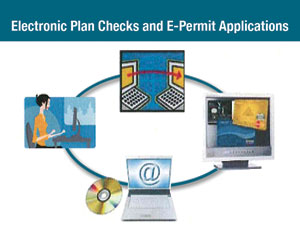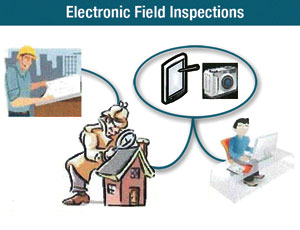Oregon, which is implementing the first statewide electronic building permitting system in the U.S., is moving slowly ahead with system development, having recently enhanced its Website and added some services. But the 10-year program, funded by a 4% surcharge on permits, is at least a year behind schedule because of a significant drop in permit applications.


For some states and most large jurisdictions, full-blown e-permitting, which includes digital filing, permit and plan tracking, plan review, payment, permit issuance and field inspection, is no longer a question; it’s an eventuality. But as in Oregon, the recession has slowed progress in Louisiana and Wisconsin and has halted or slowed progress in San Francisco, Los Angeles, Philadelphia and Chicago. Jurisdictions with programs that rely on general funds or enterprise-funded building departments have been hit the hardest by the recession, says Robert C. Wible, an “e-regulatory reform” consultant in Reston, Va.
And Oregon expects to ultimately finish its 10-year program on time, in 2017. "We do not foresee our reduced revenue to impact the long-term project schedule," says Lisa Morawski, communications director, Oregon Dept. of Consumer and Business Services, Salem. And "while the drop-off in construction activity has had an impact on our revenue, it has also increased interest in the program by local jurisdictions, who are interested in a low-cost, shared-services model of building permit management," she adds.
Even the International Code Council’s SMARTcodes project, which involves putting model building codes into a format that computer systems can understand for electronic code-compliance checking, was suspended late last year. To date, only the International Building Code’s chapters on means of egress and accessibility and the majority of the model energy code are in SMARTcode format.
But things are looking up for SMARTcodes, thanks to a promising first half of the year. “ICC...will be looking at potential partners to move things forward in the future,” says Mark Johnson, president of ICC Evaluation Service Inc., Whittier, Calif.
The recession may be slowing progress, but it isn’t ending a trend. Since 2007, the number of jurisdictions doing e-plan review, typically the last piece of the e-regulatory reform puzzle, has gone from a handful to more than three dozen, says Wible. Several jurisdictions—including Bend, Ore.; Clark County, Nev., Osceola County, Fla., and Maricopa County, Ariz.—use IT for every aspect of administration and enforcement.
Of 150 jurisdictions responding to a 2008 Wible survey, only 24% were not using information technology for code administration and enforcement. Of those, 89% said they plan to start using it in two to three years and 11% said they plan to start within five years.
Of IT users, 93% were using IT for e-permit application and processing; 30% were using IT in mobile field inspection; 21% were using interactive voice-response systems to schedule inspections and meetings; and 2.75% were using IT for electronic plan submission, review, tracking and storage.
Using the Oregon system, contractors can buy over-the-counter permits from 33 building departments, any time of day or night. They can also access their purchase history and enter a city name or ZIP code and get information about a particular building department. “One of the beauties of the Oregon system is that it allows existing e-permitting systems in local jurisdictions to link to it,” says Wible. For a city like Portland, which uses a different vendor’s e-permitting system, that’s a “huge thing,” he adds.
Milwaukee has seen increased acceptance of its e-permitting services. The use rate for electrical permits is 80%. Some 65% of all plumbing permits are done on-line, and the service is only two years old. The city’s 19-month-old heating, ventilating and air-conditioning e-permit module is used by half of permit applicants.
The Los Angeles Dept. of Building and Safety has fully implemented its e-permitting and e-inspection programs, but with a 34% drop in revenue, it has put its e-plan review project on hold. The city’s biggest challenge in implementing e-permitting was developing the e-commerce system for debit/credit-card payment, says LADBS.
Bend, which has e-permitting and e-plan review, does not allow customers to pay over the Internet because credit-card company fees are too high. Bend officials say the most challenging part of implementing the electronic process was developing a communication system to replace written notes when a submittal doesn’t fit the normal profile.
Wible says advances in software and interoperability are facilitating the transition to e-permitting. When the recession ends, jurisdictions that have implemented e-permitting “will have a distinct advantage” over the others, he says.





Post a comment to this article
Report Abusive Comment